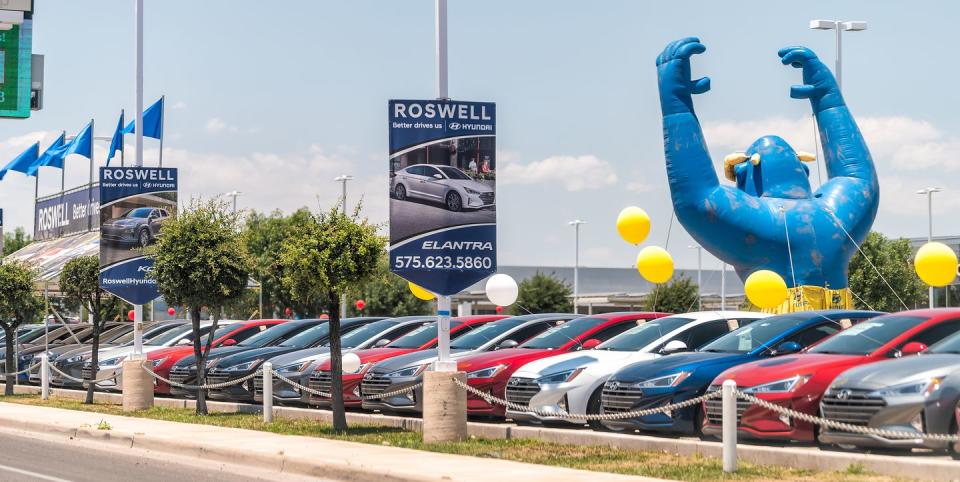Third-Quarter New-Vehicle Sales Are Encouraging, Hint at Recovery

Third-quarter new-vehicle sales are down from last year, but are up from the quarter prior, revealing what appears to be a V-shaped recovery in the industry.
FCA, Toyota, and General Motors are all showing sales declines of around 10 percent for the third quarter, but that's a dramatic improvement from declines of over 30 percent last quarter.
Honda, Hyundai, and Subaru, who all report monthly sales, saw September sales end positive.
As automakers begin to report third-quarter sales, one thing is becoming clear: the worst sales forecasts have been avoided, and new-vehicle sales are trending upward from their lows earlier this year. New-vehicle buyers haven’t left the market—a reality in line with the more uneven K-shaped recovery many economists have been reporting—and that has helped propel the recovery in sales.
Since the first quarter of 2020, the coronavirus pandemic has taken a substantial toll on new-vehicle sales; Sales from January through March fell 12.8 percent from the year prior, and quarter two saw sales fall 33.7 percent, according to the Federal Reserve Bank of St. Louis (FRED). Shutdowns to constrain the spread of the virus had large impacts on sales in March through June, but beginning in July, that trend morphed into a V-shaped recovery for the industry.
"Consistently lower interest rates encouraged new-car buyers—who were less likely to be financially hindered by the economic fallout of the pandemic—to pull the trigger on a purchase," Jessica Caldwell, Edmunds executive director of insights, said in a note. "Rising used-vehicle prices also likely made the new-car market more appealing for shoppers on the fence between the two."
Toyota's sales fell 11 percent in the third quarter year over year after having a strong month of September, where sales were up 16.2 percent. Toyota's sales fell 35.6 percent in the second quarter. Toyota's SUV and truck sales were up 24.0 and 19.5 percent, respectively, in September, with gains led by the Highlander and Tacoma.
FCA saw a similar recovery, with sales falling 10.2 percent in the third quarter, as opposed to a decline of 38.6 percent in the second quarter. Sales increases for both the Chrysler Pacifica and the Jeep Gladiator helped cushion FCA's decline, along with only a slight decline for Ram pickups.
Scarce 2021 Model Supply Is a Factor
One issue that could morph into something much more consequential is the availability of 2021-model-year vehicles, and new-vehicle inventory as a whole, as noted by Cox Automotive. Inventory levels have been much lower than the industry average over the past few months, and it remains a question as to whether that will negatively impact buying trends.
"Available Inventory is far below last year's levels, yet sales continue to show surprising strength," Charlie Chesbrough, senior economist at Cox Automotive, said in a note. "Going into the fourth quarter, the key question is: Can this continue? Clearly, new-vehicle buyers haven’t been hit as hard as other consumers during this recession, so demand is likely to remain stable over the near term."
General Motors reported such headwinds this past quarter but managed only a 9.9 percent decline in sales, which is a marked improvement from a 34.0 percent fall last quarter. GM's trucks, notably the Chevrolet Silverado and the GMC Sierra, saw sales increase this past quarter, along with several of the automaker's crossovers, including the Chevy Blazer and the Buick Envision. The automaker said in a release that "sales improved sequentially each month within the quarter."
Sales for Volkswagen fell by 7.6 percent in the third quarter, a decline that was reduced by the new Atlas Cross Sport and the Tiguan. Last quarter, VW's sales tumbled 29.2 percent.
September Sales Show a Recovering Industry
Hyundai's September sales reveal that the automaker has nearly completely recovered from the impact of the pandemic, with sales increasing 5.5 percent last month and a 1.7 percent decline in sales in the third quarter. The sales increases were led by the Palisade, Sonata, and Kona as well as the new Venue.
Subaru, similar to Hyundai, had sales increase 16.9 percent in September, a rise helped on by the Forester and Outback. In the third quarter, Subaru's sales fell 8.8 percent, which is better than the 25.3 percent decrease in the second quarter. Nissan saw a better third quarter than second, but sales still fell 32.4 percent -- last quarter they fell 49.5 percent. Although most of Nissan's nameplates had sales fall, both the Versa and the Kicks saw sales increase this past quarter.
Ford sales declined by 4.9 percent last quarter, a solid recovery after sales fell 33.3 percent in the second quarter of this year. Trucks and SUVs were a bright spot for Ford in the third quarter, as sales grew 0.6 percent and fell just 0.7 percent, respectively. Ranger sales jumped 8.2 percent.
Honda's sales ended positive in September, seeing a 11.5 percent rise, while over the course of the whole quarter, sales fell 9.5 percent. Sales increases among the CR-V and Pilot in September helped push that positive finish. In the second quarter, sales declined 15.5 percent for Honda.
You Might Also Like

 Yahoo Finance
Yahoo Finance 